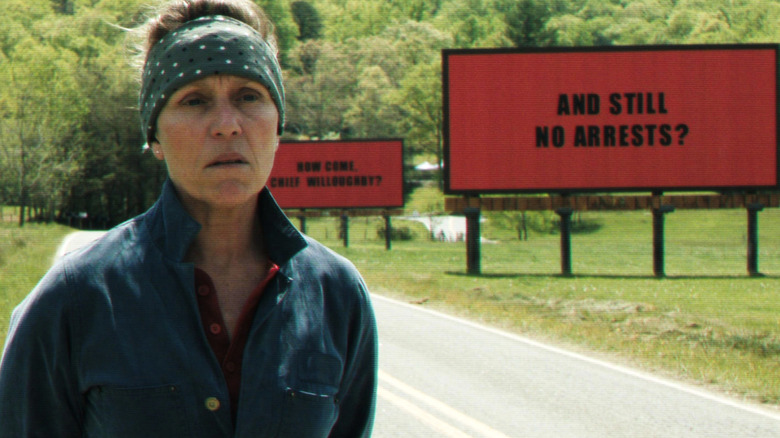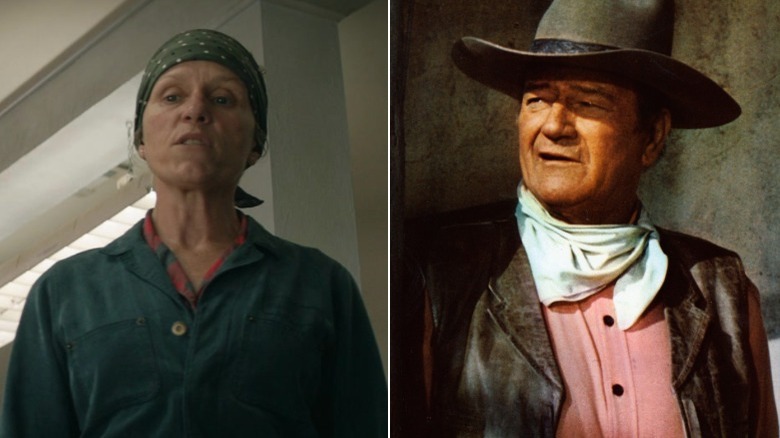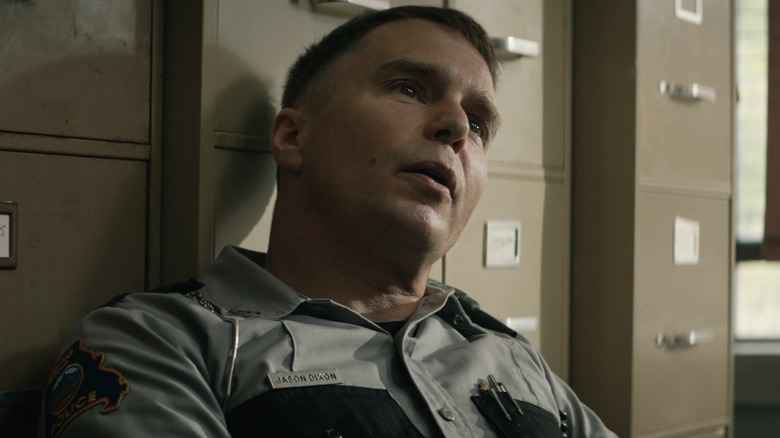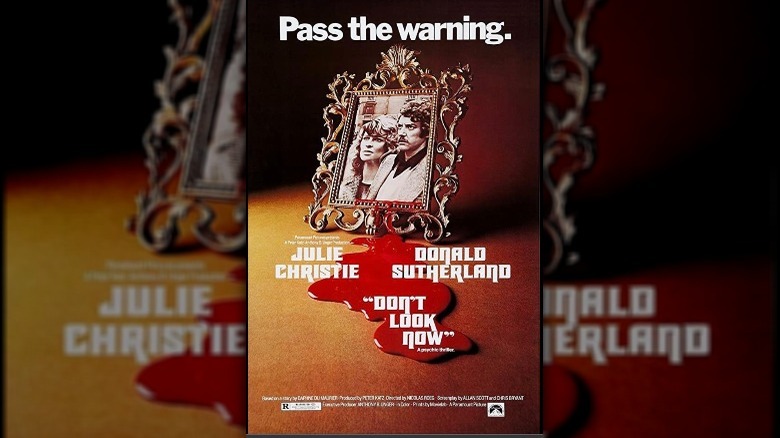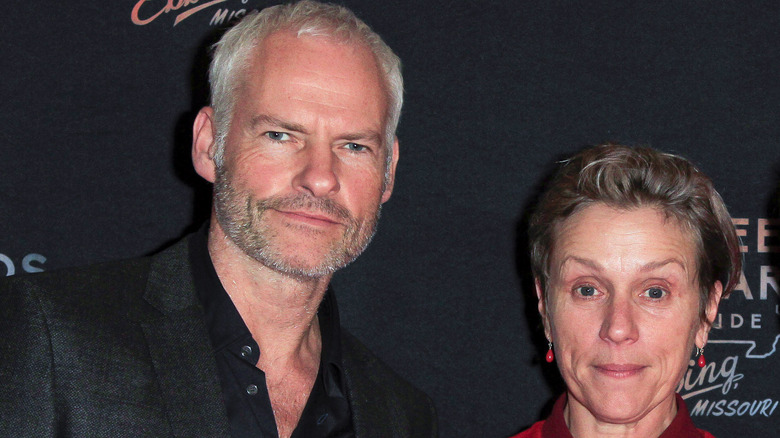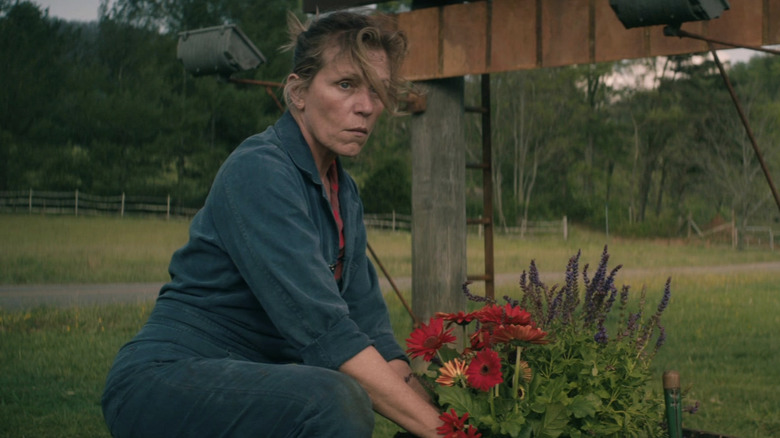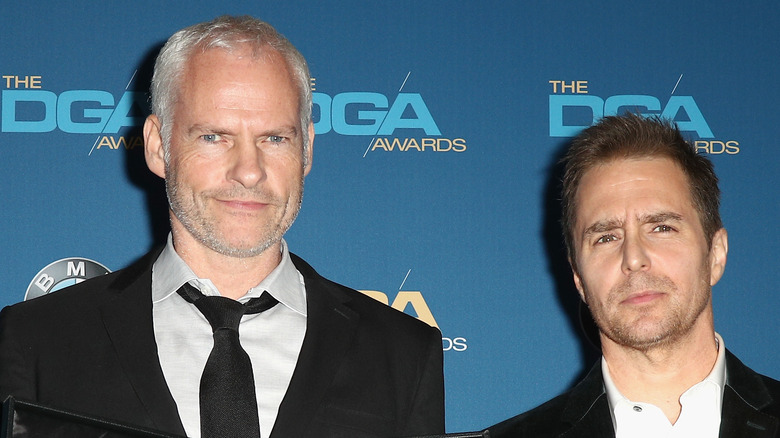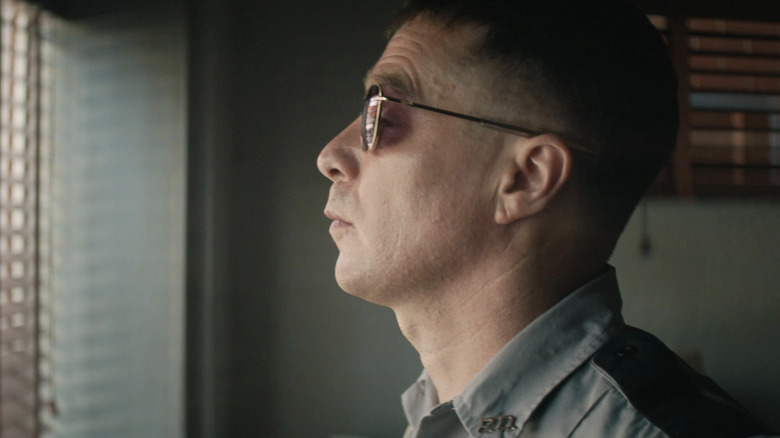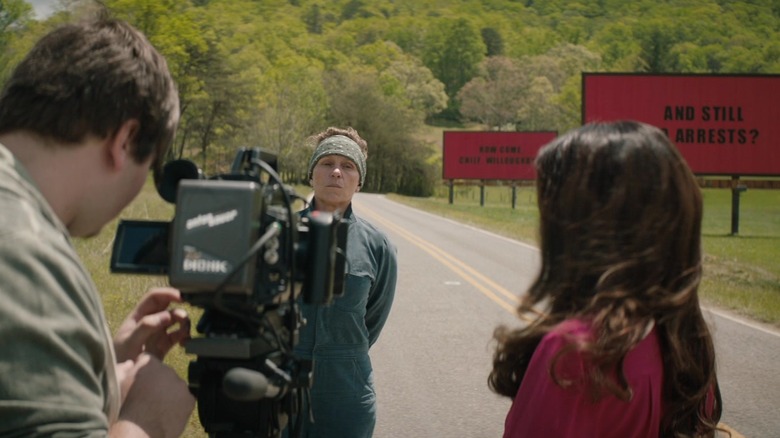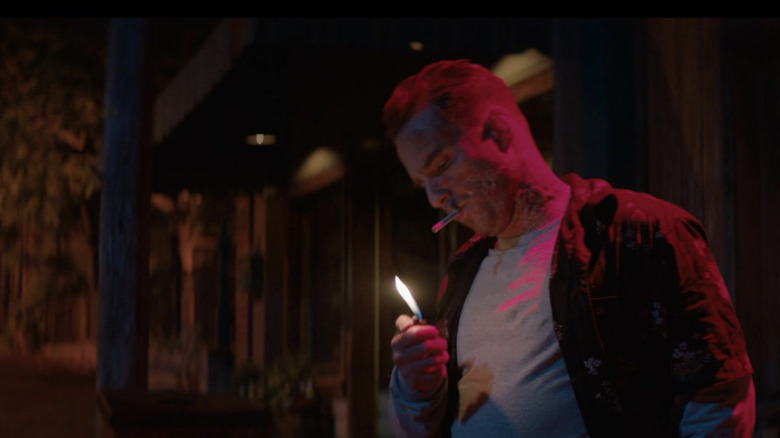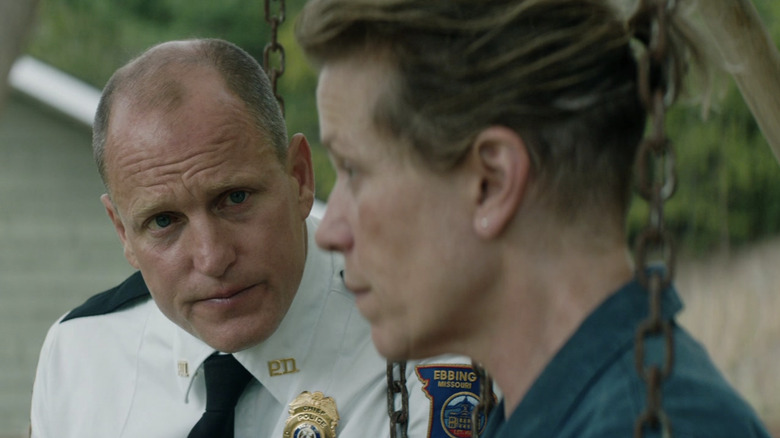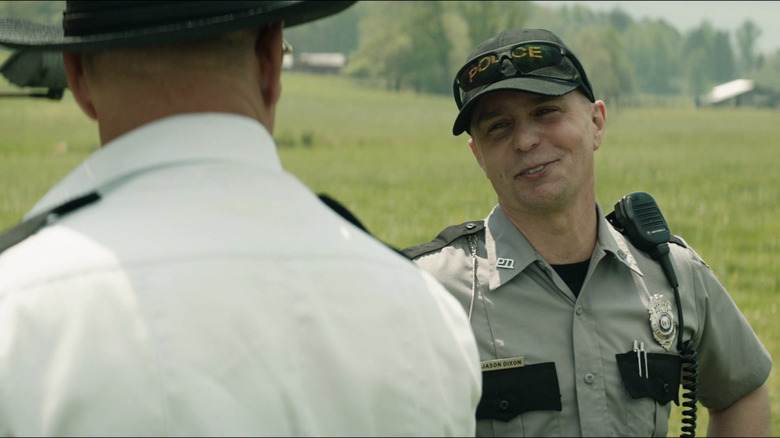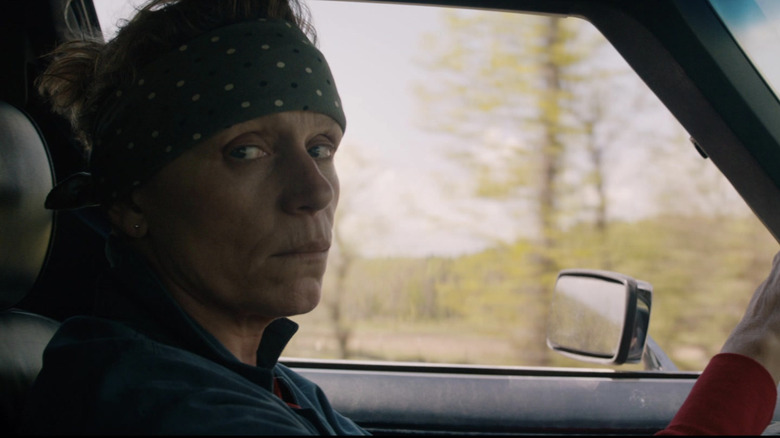The Untold Truth Of Three Billboards Outside Ebbing, Missouri
Fans of Sam Rockwell and Colin Farrell are probably already aware of Martin McDonagh's films "Seven Psychopaths" and "In Bruges," but they may not know that McDonagh's violently comedic writing also produced one of Frances McDormand's best films as well: "Three Billboards Outside Ebbing, Missouri." The 2017 film follows the rage and grief of a mother, Mildred (McDormand), who has rented three billboards in order to call out the local police department for their incompetence in finding her daughter's killer. The emotional film manages to cover a wide range of issues from racism and violence against women to police brutality.
"Three Billboards Outside Ebbing, Missouri," while controversial, quickly became known as one of the best films of 2017. Not only was it well-reviewed by critics and filmgoers alike, but it had a strong showing at the box office, growing in popularity as word of this dark comedy's excellent acting and shocking storyline spread. Eventually, "Three Billboards Outside Ebbing, Missouri" grossed over $160 million worldwide.
The film also went on to become an awards season darling, winning over 133 awards, including two Oscars, in 2018. And while the award-winning film's legacy has grown over the years, here are a few facts about the film that even the most enthusiastic audience member might not know.
Classic male actors inspired Frances McDormand's performance
It is well-established that Hollywood doesn't always create the most diverse roles for women: Rage, unfiltered and raw, is usually given to male characters. Naturally, Frances McDormand does everything she can to buck that trend, having no fear of portraying unlikable or offbeat characters. Mildred Hayes is a force of nature; rude, aggressive, and unapologetically angry, she strides through town, determined to bend its racist police force to her will.
When McDormand and McDonagh discussed the role of Mildred with The Hollywood Reporter, McDormand stated that she based her portrayal of the role on male film stars. "When I was looking for iconic characters in cinema that I might model myself after as Mildred, the only ones I could find were male...So really the one that I latched onto the most was John Wayne. I used John Wayne's walk."
McDonagh viewed the character as "more as a Marlon Brando," than a John Wayne figure, as he told the New York Times. In fact, they deliberately set out to craft Mildred as an unlikable figure; according to McDonagh, "we both loved her, but didn't want to do anything to make her more likable or lovable." In the end, the decision to play Mildred as a forceful character, uncompromising in her anger, ended up being the strength of the film. After the film's release, McDormand's masterful portrayal of Mildred led to widespread acclaim and an Academy Award.
Sam Rockwell wanted to get the accent perfect
Sam Rockwell's character Dixon in "Three Billboards Outside Ebbing, Missouri," is, to put it bluntly, a truly terrible person. Dixon is an amoral, bigoted racist who utilizes brutality and violence to achieve his own ends. While his incompetence is often played for laughs, his character is ultimately a dark and disturbing one. Since the film's release, Dixon's character has come under the most scrutiny and caused the most controversy.
Rockwell was intrigued by the troubled character and, according to an interview with The Hollywood Reporter, offered his perspective that Dixon should have a strong accent, an idea that director Martin McDonagh wasn't sold on originally. Eventually, dialect coach Liz Himelstein was brought in to assist. Not wanting to skimp on authenticity, Himelstein and Rockwell decided a deep dive was needed to get the perfect accent for Dixon.
Enter Officer McMullin of the Springfield Police department, who was enlisted to give Rockwell some pointers on local law enforcement lingo and help him perfect a Southwest Missouri accent. A few phone calls ensued between the two, with McMullin actually reading off some of the lines in the script so Rockwell could record and practice them later, and Rockwell even accompanied McMulling on a ride-along, for authenticity's sake. Don't ever let anyone say that Sam Rockwell is not fully committed to his craft.
The film alludes to a classic psychological thriller
Film history buffs are probably already aware of the cult classic "Don't Look Now" and its influence on psychological horror films. The 1973 British film follows the breakdown of a couple who have recently lost their young daughter in an accident; grief becomes the catalyst for the unexplained events of the film. "Don't Look Now," starring Donald Sutherland and Julie Christie, famously uses a red motif to signal the strange and disturbing throughout.
Another film that seems to have a lot of red in it? The correct answer is, obviously, "Three Billboards Outside Ebbing, Missouri." Mildred's bandana is red, the billboards are a glaring blood red, and for eagle-eyed viewers, dozens of other items pop with that same color: swing sets, telephones, even a character called "Red."
But using the color red isn't the only reference to the classic film. Mama Dixon is actually watching "Don't Look Now" on TV, her son on the couch next to her. "Three Billboards Outside Ebbing, Missouri," is a film with many central themes, but its focus on the ways that trauma and grief change us is key. Tying "Three Billboards Outside Ebbing, Missouri" to a famed horror flick with the same message brings home the darker, more emotional aspects of the film.
McDormand asked director Martin McDonagh to write a part for her
According to an interview with Collider, McDonagh, "had her [Frances McDormand's] voice in my mind" while he was writing the character of Mildred Hayes, admitting later that the film would "have been screwed if she had said no," in an interview with Vanity Fair.
However, most people aren't aware that Frances McDormand actually approached McDonagh to write a part for her. In an interview with Popsugar, McDormand confessed that she'd met McDonagh in 2005 after a Broadway premiere, saying, "I introduced myself and I'd just read an article that he was going to try his hand at film. He said, 'I know your work, I love your work, you should consider doing one of my earlier plays because they're such great female characters.' I said, 'Yes, good idea, although I hear you're making film, perhaps you'll write a part for me.'"
And thus, Mildred was born, perfectly crafted for McDormand. In that same interview with Vanity Fair, McDonagh said that he'd never "written a character as strong as her [before], let alone a female one." "Three Billboards" fans can be glad that McDormand and McDonagh were able to create such an outrageous and compelling character.
Mildred's jumpsuit was a key influence on the film
While building the character of Mildred, Frances McDormand relied on a specific garment: The jumpsuit Mildred wears throughout the film. In an interview with Popsugar, McDormand talks about how important the outfit was to her process, saying, "But I think what the key was for me was the jumpsuit. Once she made a decision to take action and not die from guilt and grief...She buzzed the back of her head, she put on the jumpsuit, she put on the bandana and then she went out and she was armed...So it wasn't about weapons to hurt people but armor to protect herself from whatever came her way."
In fact, the jumpsuit came to represent Mildred so much that McDormand refused to wear anything else during the film. At one point, Mildred goes on a date with Peter Dinklage's character, James, but is still wearing her favorite look. McDonagh actually suggested to McDormand that her character might wear a dress on a date, however, Frances did not agree. According to an interview with Vanity Fair, McDormand told McDonagh, "Why would I dress up? I'm still at war. Nothing's been solved." And so the jumpsuit stayed.
Sam Rockwell is McDonagh's muse
While Frances McDormand might have been destined to play Mildred in "Three Billboards Outside Ebbing, Missouri," she's not the only actor who inspires Martin McDonagh. Like many directors, he has a few favorite actors he tends to bring into his projects, Woody Harrelson, Colin Farrell, and Sam Rockwell chief among them.
In a 2017 interview with Collider, McDonagh talked about the importance Sam Rockwell plays when he's writing a new script. "I've always got him in my head when I'm writing an American character of that age. There's something freeing about having Sam in your head when you're writing. He can play the darkest of characters and the nicest of characters, too, and both in one person, to a degree...So, if anyone has ever been a bit of a muse then I think it's Sam." Rockwell's character in this film is a violently racist police officer, a role that would be a challenge for any modern actor.
Yet, Rockwell has been open about the respect he has for McDonagh as a creator; in an interview with the Los Angeles Times, Rockwell described the joy he has in reading McDonagh's work, saying "It's like opening a Christmas present when you get a Martin McDonagh script." He's also gone on record with The Hollywood Reporter saying that he believes McDonagh is " arguably one of the best writers on planet Earth." High praise, indeed!
The brutal scene in the police department was shot in one take
Pulling together a full-length feature is a difficult feat for any director, but add in a tricky, physically challenging scene done in one long take? Impressive. McDonagh and his team achieved the famed one-cut take in "Three Billboards Outside Ebbing, Missouri," during one of the film's most intense scenes: Dixon's shocking violence against Red Welby.
Dixon (Sam Rockwell) brutalizes the young man who rents Mildred the billboard space, Red Welby (played by Caleb Landry Jones), beating him viciously and then throwing him out a window. The two-minute scene was filmed in one long, continuous take: We watch Dixon move through two rooms, throw Red Welby out the second-floor window, run down the stairs, and then continue on with his gruesome work, without any clever editing. The scene reportedly required over a day and a half of rehearsals and five takes to get right. By choosing to present the scene in just one take, the audience is forced inside the moment, viscerally experiencing it until it becomes almost emotionally overwhelming, creating one of the most powerful sequences in the film.
The use of billboards to get police attention has taken off
The inspiration for "Three Billboards Outside Ebbing, Missouri" came while McDonagh was touring the United States and saw several billboards raging against the police after the death of Kathy Page in 1991. Page's father, James Fulton, put up billboards demanding answers to his daughter's murder; sadly, the case remains unsolved to this day.
"Three Billboards Outside Ebbing, Missouri" introduced the world to this simple, but dramatic way of holding police departments accountable for their investigations. There have been multiple instances of billboards in use since the film's release, most notably after the Grenfell Tower fire in 2018, when activists parked three billboards outside the tower, demanding to know why there'd been no arrests yet. Frances McDormand was actually asked what she thought of the Grenfell billboards after her Oscar win. In response, McDormand praised the protestors, saying "activists are taking that kind of statement and putting it out there — billboards still work, so I think that it's really exciting."
Sam Rockwell spent weeks preparing for his role
Sam Rockwell was willing to go to some interesting lengths to prepare for his portrayal of Dixon. Not only did he fly to Missouri for a police ride-along and hire a dialect coach, but Rockwell was also intent on showing realistic specific physical reactions to events within the film.
A key moment in "Three Billboards Outside Ebbing, Missouri," is when McDormand's character Mildred launches a molotov cocktail through the police station window, burning up the building and unintentionally injuring Dixon who was inside at the time. After being released from the hospital, Dixon lights a cigarette before picking a fight in a bar; it's this scene, this small moment of his hands shaking as he lights up, that Rockwell went to such lengths to portray correctly.
According to an interview with GoldDerby, Rockwell describes meeting burn victims in preparation for the role, "they shared some stories, so that informed a lot of me subtext in that scene and I worked with an acting coach and he suggested that I pretend to be drunk...so my character sort of pretends to be a little wobbly, goes out to smoke a cigarette to get the license plate, and then we did a little bit with the cigarette because the burn victims had told me that they were a little squeamish around fire after they'd been burned and I thought that that was an interesting detail, I wanted to fit that in there."
Woody Harrelson's favorite scene of the film is shocking
Martin McDonagh and Woody Harrelson have been friends and frequent collaborators for over 20 years. Harrelson has great respect for the director and writer, revealing in an interview with The National that he thinks McDonagh is a "certified genius." In fact, Harrelson once turned down a chance to be in "The Pillowman," McDonagh's 2003 award-winning Broadway play; since then, Harrelson has said that he'll be doing every role McDonagh offers him.
Similarly, Harrelson has talked about his friendship with Frances McDormand and his respect for her as an actor. And it's his pivotal scene with McDormand that Harrelson says was his favorite of the whole film.
During an argument between Mildred and Willoughby over the investigation, he suddenly coughs blood into Mildred's face, and suddenly the scene shifts from a yelling match to a brief, comforting moment. According to an interview with The Hollywood Reporter, Harrelson believes it's a beautiful scene, where "you have that one thing going on where we're each one-upping the other more or less, and then suddenly, through the introduction of something much greater than our grievances with each other — the presence of death, really — it just becomes about something totally different...you never really see a scene like that where two people are squaring off as archenemies in a way, and then — boom — it turns into treating each other with respect and dignity."
The character of Dixon caused a major controversy
Just weeks after "Three Billboards Outside Ebbing, Missouri" was released, there was a swell of controversy, specifically centered on Sam Rockwell's character. Dixon, the audience is told, tortured a Black man while in police custody — although this happens prior to the events of the movie, his racial slurs and bigoted attitude are present throughout. While Sam Rockwell was praised for his portrayal of Dixon, even winning the Academy Award for best supporting actor, there was much discussion about Dixon's redemption, and whether that was an appropriate ending. Can Dixon's character have redemption if he never even acknowledges his racist behavior?
Prior to the release of the film, in an interview with VPRO Cinema, the interviewer comments that Rockwell was able to make a "violent, racist mama's boy" into a sympathetic character, to which Martin McDonagh agreed, stating that was down to the "sensitivity and a vulnerability" in Rockwell's acting. However, after the backlash to the film, McDonagh walked back on the idea that Dixon is sympathetic in the end, saying in a 2020 interview with the New York Times (and in a released statement), "I think he's still the same dick that he was." A realization, perhaps, that the character he created didn't deserve the redemption arc he was given.
The town of Sylva, North Carolina became a big part of the film
Ebbing, Missouri is not a real town, and while writer and director Martin McDonagh did base his script on three real billboards outside of a Texas town, the setting for "Three Billboards Outside Ebbing, Missouri" needed to embody what McDonagh clearly envisaged as a small town in the South. Apparently, Martin McDonagh actually spent three days scouting locations for the perfect, quintessential American main street, finally settling on the town of Sylva, North Carolina as the backdrop for his vision.
Sylva, North Carolina was happy to take on this role, and many of the town residents enjoyed the filming, often filling the streets while the cast and crew were working. In fact, you can still see the burnt-out letters of "Ebbing Police Department" on the Sassy Frass furniture store, the location of the fictional police station.
The local townspeople of Sylva were also quite happy to help the actors get into character: According to Jason McMahan, manager of Your Ear Music Emporium, in an interview with Discover Jackson, Frances McDormand had a memorable visit to his shop. She asked if he could play some angry music for her. "After shuffling through a few songs that weren't quite what she needed to get into character, I finally found the right genre of music to get her amped up. It was interesting to see how far they go to truly get into the right mindset for their roles."
McDormand brought her hatred of tears to the set
Frances McDormand is on a mission to educate the world on the "variety of ways in which women can express their emotion," which she told The New York Times in a 2017 interview. For McDormand, as an actress who has never shied away from playing "difficult" women, this means allowing her character the freedom to not cry. According to McDormand, "In general, the women in a supporting role to a male protagonist — cry a lot." In Olive Kitteridge, McDormand insisted that her character wouldn't cry, happily debating that fact with director Lisa Cholodenko.
Now, while McDormand probably doesn't "hate" tears, per se, she is fierce in her fight to use them sparingly. According to Martin McDonagh in an interview with Vanity Fair, McDormand pushed back against McDonagh when he tried to insist that Mildred should cry in a scene. For McDormand, Mildred wouldn't ever have cried during this portion of her life, because she's beyond grief, now showing only rage. "I think she had determined that audiences are seeing actors crying too much on-screen these days."
